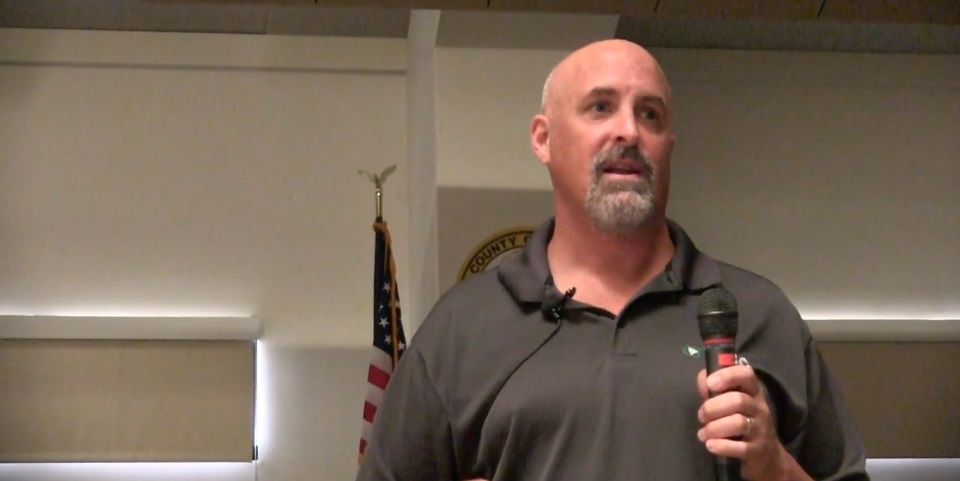Researchers and land managers rely on input from the public to better learn how invasive species like Rapid Ohia Death are affecting them. This Community Input Forum at the community forum on Rapid Ohia Death held at the West Hawaii Civic Center in Kona on March 30, 2019, provided a chance for the experts to talk directly to citizens and get their feedback on the latest research and management tools being used to combat ROD.
Invasive Species
Today, people who participated in the community forum on Rapid Ohia Death held at the West Hawaii Civic Center in Kona on March 30, 2019, break into small groups to ask questions and get answers from the experts. The discussion was focused on the five things people can do to help prevent the spread of this fungal disease.
(Honolulu)-The State of Hawai'i today took a significant step towards launching its first-ever forest carbon sequestration program by selecting a standard to ensure a reliable and transparent process and to guarantee the environmental integrity of the credits resulting from it. The DLNR Division of Forestry and Wildlife (DOFAW) awarded the contracts to Verra, one of 4 standard-setting firms that submitted proposals.
In our continuing series of video presentations on Invasive Species and Biosecurity, Bill Buckley of the Big Island Invasive Species Committee details the latest management tools and actions being used to fight the fungal disease, Rapid Ohia Death. This presentation is from a community forum on Rapid Ohia Death held at the West Hawaii Civic Center in Kona on March 30, 2019.
In this video Dr. Lisa Keith, a USDA researcher presents findings from Dr. Marc Hughes of the University of Hawaii on the latest scientific information on how to treat wood and trees that have Rapid Ohia Death to keep the fungal disease in check and from spreading to other wood or trees in the forest. This presentation is from a community forum on Rapid Ohia Death held at the West Hawaii Civic Center in Kona on March 30, 2019.
In the first part of our video presentations on Rapid Ohia Death, Dr. Lisa Keith of the USDA Agricultural Research Service and one of the primary scientists working on ROD, presents the latest scientific findings including details on the two different strains of the fungal disease that are killing trees on at least two islands. This presentation is from a community forum on Rapid Ohia Death held at the West Hawaii Civic Center in Kona on March 30, 2019.
In our final video from the Invasive Species & Biosecurity in Hawai’i: New Tools and Opportunities for Public Participation, held at the William S. Richardson School of Law at the University of Hawai’i on March 23, 2019, John-Carl Watson of the Ko‘olau Mountains Watershed Partnership details all the efforts happening around the state to control and combat the invasive Albizia tree.
In our final video from the Invasive Species & Biosecurity in Hawai’i: New Tools and Opportunities for Public Participation, held at the William S. Richardson School of Law at the University of Hawai’i on March 23, 2019, John-Carl Watson of the Ko‘olau Mountains Watershed Partnership details all the efforts happening around the state to control and combat the invasive Albizia tree.
Our series of video presentations on invasive species and biosecurity continues with Rob Hauff, State Protection Forester with the DLNR Division of Forestry and Wildlife and Ambyr Mokiao-Lee, Statewide Rapid Ohia Death Outreach Specialist, University of Hawaii, discussing the latest on detection and rapid response to any breakouts of this fungal disease which is killing ohia trees on at least two islands. Ambyr reveals the simple steps we can all take to help prevent the spread of the disease.
“Dr. Cynthia King, entomologist with the DLNR Division of Forestry and Wildlife presents the latest research and management issues for controlling mosquitoes in Hawaii. She reveals efforts and techniques being used to combat these pests which are a risk to human healthy and native birds. Her presentation is from the Invasive Species & Biosecurity in Hawai’i: New Tools and Opportunities for Public Participation, held at the William S. Richardson School of Law at the University of Hawai’i on March 23, 2019.










